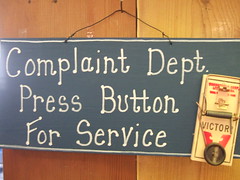This is an example of an article written by Jim Feldman for a publication or newsletter. Jim is an author, keynote speaker and consultant who writes and speaks about Change Management, Customer Service and Innovative Problem Solving. Contact us about using Jim as an author, interview or speaker at 312-527-9111.
photo credit: Life As Art
Mistakes do occur.
People do have bad days.
Systems are not all user friendly.
Customers get put on hold, transferred, and hung up upon.
How do you prevent a minor incident from turning into a major confrontation that results in losing a customer?
How do you manage inevitable complaints?
How do you become more effective in handling disgruntled and irate customers while still maintaining company profitability?
As a business owner, I have always been a front line employee. I have seen it all. I have heard it all. And to make it more educational, I have worked with dozens of companies, both big and small, as a consultant. If you have ever been on the firing line and the complaining customer looks to you for help, I think the next few ideas will be worthwhile.
Books, seminars, training manuals, and advice from your mother to your supervisor do not prepare you for the verbal or written tirade you may receive from an unhappy customer. However there are some steps you can take to minimize, and, yes, turn around, dissatisfaction. As someone said after understanding how to take pride in the results and embrace the challenge, “I like to see them come in smokin’ and go out smilin’.”
There are three steps in solving a complaint.
Focus On Discovery
- Get all the information.
- Listen!
- Look at the customer.
- Do not talk.
- Do not argue.
- Take notes.
- Maintain your temper and composure.
- Devote all of your attention to the customer. Do not take other calls. Do not have other discussions. Do not do other work.
- It is your job here to establish a relationship.
Reaffirm Your Discovery
- Reiterate the critical issue or problem.
- Maintain a professional business position.
- Do not agree or disagree but identify all issues.
- Ask the customer for their wanted resolution.
- Clarify their needs and wants.
- Make the resolution a team effort-you and the customer.
- Offer a consolidated resolution that is acceptable to both you and the customer.
Create A Joint Resolution
- Get acceptance from the customer.
- Get commitment from the customer.
- Get resolution from the customer.
- Clarify their response.
- Develop a plan of action that resolves all issues.
- If you are not the decision-maker then write down the resolution and take it to your supervisor or call your supervisor. Do not pass it along. Take control and ownership.
- Thank the customer for caring enough to complain.
- Your goal is to get the customer to use your service or purchase your product again. Did you reach that goal?
Sometimes customers are understanding. Sometimes they are not. In all cases making an adjustment may mean you keep a customer for life. Arguing never keeps a customer. If the customer has a problem, you have a problem. Make it a worthwhile experience for both of you. Thank the customer for complaining.
Remember there is a big difference in being disappointed in the product or service and angry at the manner in which they were treated. The earlier you understand and communicate your understanding to the customer, and the fact that you are ready to act, the sooner stress is reduced for both of you. Your management of a complaint should never allow it to escalate beyond disappointment.
When you have reached resolution ask the customer for advice.
“What could we have done to improve your experience with us thus avoiding this situation reoccurring with others?”
“What one other thing could we have done to improve the experience you had with our company?”
This makes your customer part of your team, not apart from your team. If they respond in a favorable manner they will tell others about the experience. They will tell others to use your services because you care enough to ask, to improve, and to respond.
Remember in all cases to follow up. Send a note. Make a phone call. Use email. Do whatever it takes to contact your customer to make sure that you reinforce your need to make sure they are still happy and satisfied.
Keep a complaint log. Use it to train others as well as yourself for future issues. Share the information.
Your intent is to re-establish the customer’s confidence in your company so that they will not hesitate to recommend you to others or use you again.
Whenever possible, call the customer before the customer calls you. Try to find the solution to the problem prior to the customer bringing it to your attention. Make the experience pleasurable.
The goal of great customer service is to bring the customer back.





